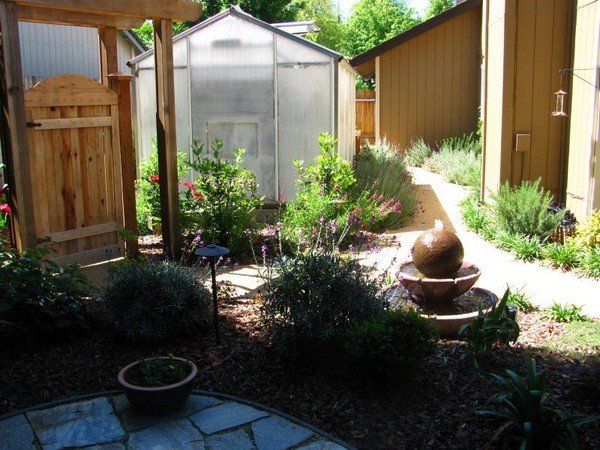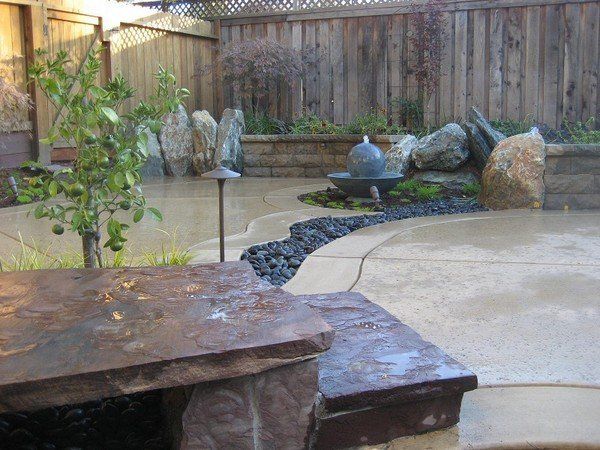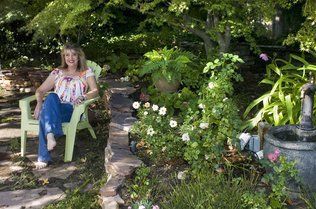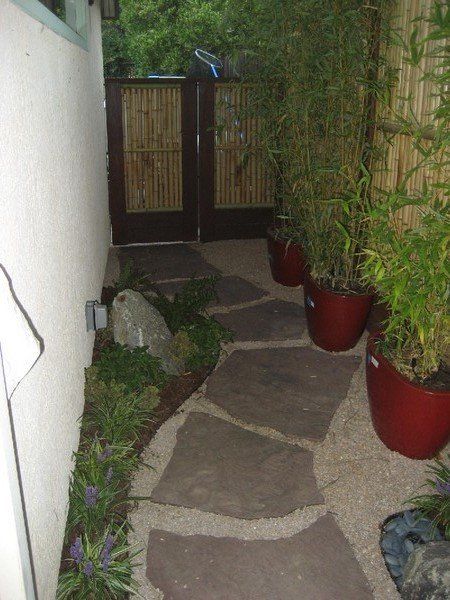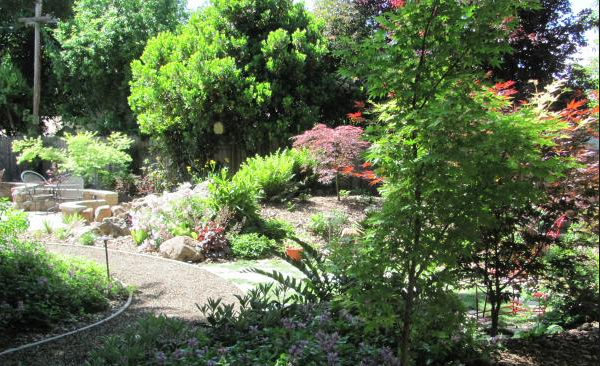Recreate your landscape with water efficient tips
- By Susan Silva
- •
- 04 Feb, 2014
- •

With a little ease of some rain last week, homeowners are still feeling the effects of the drought in the region.
Susan Silva, a professional landscape designer, has some ideas for homeowners on how to stay water-wise in your own backyard.
Silva, owner of Susan Silva Landscape Design based in Orangevale, said the biggest step homeowners can do to reduce water costs is to get rid of water-hungry grass lawns.
“The primary design for water reduction is to cut back on your lawn,” Silva said. “There are so many other beautiful things your can do to fill that space including gravel, dry beds, shredded bark and most trees. Most trees require less water after maturing. Trees will also help provide extra shade for less watering as well.”
Silva said she followed her own advice and replaced her lawn with a unique design including adding thyme and other ground covers along flagstones in place of her lawn. The ground covers add green color and nice fragrances to landscapes, without much water use.
She said landscapes can also become personalized with curvy, elegant designs through concrete paths, gravel and shredded bark.
Adding a pond-less waterfall feature near a bench and pathway can also create an enjoyable space without using a lot of water, she said. The water is contained in an underground reservoir, so while the waterfall is not being used, it is stored safely in the reservoir without evaporating. The water will then be constantly recycled as the waterfall is turned on, giving a soft background to the yard.
Silva said when cutting back water use in residential landscapes, proper drainage is a must.
“Low-flow nozzles and watering timers are critical to managing a drought tolerant landscape,” Silva said. “Shredded bark densely spread in the planter beds keeps the moisture in the ground and helps to prevent the weeds from growing. A weed cloth can also be used under the bark in sparsely planted beds. Grading and drainage is super important for a healthy water-wise yard.”
Silva said other types of hardscape, in addition to gravels and dry creek beds, are good choices to use in drought conditions.
“Patios and walkways can be made in stone, pavers, concrete, brick, etcetera,” she said. “There are so many choices and colors providing practical areas and paths in your outdoor living spaces.”
Susan has been designing residential landscape plans for more than 30 years. She has been in Orangevale since 1986.
Silva specializes in all types of landscapes, including Asian landscape design, rural gardens, formal designs, cottage gardens, Mediterranean designs, natural gardens, low-maintenance gardens and dog-friendly yards.
“Basically my backyard is my sanctuary, and I like to do for others as I would do for myself,” she said.
For more information, visit susansilva.com.
Water-wise plants that love the sun and blend well together, provided by Susan Silva:
- Salvia (sage), one of my favorite varieties is Salvia microphylla “Hot Lips” with its vibrant coral red and white flowers that bloom for months.
- Lavandula angustifolia (English lavender), “Thumbelina Leigh” is a great choice for lower foreground color with its bright purple flowers and compact form.
- Cistus skanbergii (rockrose), it's a low compact grower with a profusion of pink flowers and grey-green leaves.
- Dwarf varieties of spruce, pine and cedar are nice for a focal point next to a boulder outcropping.
- Nandina domestica (heavenly bamboo), my favorite is “Fire Power” with its compact size and rich burgundy/red leaves.
- Gaura lindheimeri, the variety “whirling butterflies” is extra special. The abundant, white flowers on branching flower spikes flutter in the breeze like butterflies. It's also a wonderful plant for a “moon garden” with flowers that pop when lit with moonlight.
- Thymus (thyme), they are all wonderful choices for dense ground covers with savory fragrances.
Water-wise and choice residential trees, provided by Susan Silva:
- Arbutus unedo (strawberry tree), the branches of this tree are gnarled and rich red-brown in color with dark green leaves. Birds love the strawberry tree.
- Lagerstroemia indica (crape myrtle), boast red, pink, purple or white blooms all summer long and have rich fall color as well. They come in many sizes and shapes.
- Pistacia chinensis (Chinese pistache), produces beautiful leaflets and gorgeous fall color, a choice shade tree.
- Laurus nobilis (sweet bay), these trees have the bay leaves used in cooking.
- Celtis (hackberry), tough fast growing shade trees with beautiful bark and all are deep rooting.

It will take thirty years to replace a thirty year old tree. A lawn can be restored in just a couple of months.
Kyle Floyd, with Green Acres Nursery reminds customers that it's the lawn that is the larger culprit for consuming water and not the trees. Unlike lawn, a majority of trees can withstand drought, but still need to be properly watered based on the tree's species and size.
It's essential to understand trees and their water needs. Most tree roots are in the top eighteen inches of soil, but studies show the greatest number of tree roots consuming water, oxygen and nutrients are in the top six to eight inches.
- A general rule is to use approximately ten gallons of water per inch of the trunk's diameter (width of trunk measured at knee level) for each watering. General formula: Tree diameter times five minutes equals total watering time.
- Example: When hand watering using a garden hose at medium pressure, it will take about five minutes to produce ten gallons of water. For a four inch diameter tree, it should receive forty gallons of water. Multiply by five minutes for a total watering time of twenty minutes.
- Distribute water evenly under the tree's dripline.
Water early in the morning or after the sun has gone down. These are the times when trees restore the water lost during the day. Also, be sure to add mulch around the trees to reduce soil temperature and decrease water evaporation.
Soaker hoses and drip systems keep the trees healthy while using less water. They soak into the ground where the water is needed, and not run into the street and drains. Long, slow watering to a depth of twelve inches with soaker hoses or in-line emitter drip systems buried below three to four inches of wood mulch is often recommended. Generally in warmer months, younger trees need to be watered twice a week, and most mature trees every two weeks.
Landscape contractor, Steve Irwin of Alpine Terrace Landscaping often advises using soaker hoses placed around the drip zone (area shaded) of the tree with timers. For extra large established trees like Sequoia sempervirens (Redwoods), Steve advises watering these giant trees with soaker hoses for a twenty-four hour period every two weeks in the warmer months.
An easy and inexpensive option for deep & slow watering for very small trees is to water them using a five gallon bucket. Steve Irwin recommends puncturing a very tiny hole at the the base of the five gallon bucket (thirty-second of an inch), place the bucket under the tree's drip-line, and fill to the brim with water. This method should be done twice weekly per small tree, moving the bucket (s) when empty to other spots within the dripline.
Trees provide shade and shelter to our homes and wildlife, and most importantly trees provide the healthy air all of us need to breathe. It's critically important for our health and environment to keep our trees watered, healthy, and producing oxygen.
According to chemistry expert, Anne Marie Helmenstine, Ph.D in her article, "How Much Oxygen Does One Tree Produce?", are the following quotes from studies made of different trees regarding the overwhelming importance about the oxygen our trees produce.
"One acre of trees annually consumes the amount of carbon dioxide equivalent to that produced by driving an average car for twenty-six thousand miles. The same acre of trees also produces enough oxygen for eighteen people to breathe for a year." - NY Times
"A mature leafy tree produces as much oxygen in a season as ten people inhale in a year." - Arbor Day Foundation
"On average, one tree produces nearly two hundred sixty pounds of oxygen each year. Two mature trees can provide enough oxygen for a family of four." - Environment Canada
